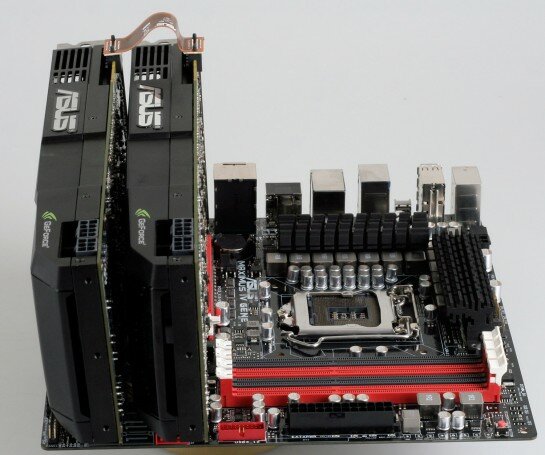Intel’s latest Z68 chipset for its second generation Core processors has had a great reception since its launch early in May, thanks to its brand new combination of SSD caching from Intel’s Smart Response Technology, and GPU switching technologies from Lucid Virtu, that open up a new range of alternative PC building options for performance enthusiasts.
The ROG team liked it so much they decided to put it on their latest micro-ATX gaming motherboard: que the Maximus IV GENE:
For those unfamiliar with ROG’s naming, the Extreme is aimed at pro-overclockers, the Formula is the high-performance gamer middle ground, while the GENE is for the portable, small form factor user and all-round gamer. For the LGA1155 platform there’s currently no Formula option though yet, so the GENE will fill this gap for now. Remember you can still put micro-ATX boards in full ATX cases.
Gaming cored

Gaming Cored: SLIing up your GENE is no problem, but make sure you have enough airflow to keep those cards cool.
Even with its smaller size it still crams in two PCI-E 16x lanes for SLI or Crossfire, and eight phase DIGI+ VRM and DIP 2 technology other ASUS high-end boards use. At least now we can finally build a multi-GPU gaming system and apply a supreme K-series overclock, all while also fitting it into a unique case like the Silverstone FT03. Tell me that’s not tempting!
Lucid Virtu tech is also included, so the graphics output can switch between PCI-E graphics card(s) and the onboard Intel processor graphics on the fly. This means there’s less heat generated between gaming sessions, which is good for those using smaller cases. If you don’t need it you can choose not to use it simply by not installing the software, so it won’t interfere.
SupremeFX X-Fi2, Intel LAN and ROG Connect
Other supporting features include the SupremeFX X-Fi2 audio, an Intel Gigabit Ethernet (82579 PHY), power/reset/clear CMOS buttons and a couple of iROG (FPGA) chips with firmware borrowed from the Maximus IV Extreme. One of which powers ROG Connect that lets you overclock and tweak the settings directly from another PC, netbook or notebook over USB, so if you do fancy really tweaking and pushing the CPU overclock this is great way to do it ‘hands-off’.
True UEFI with ROG upgrades
Underneath, and the old BIOS has again been thrown out in favour of a true UEFI BIOS with its high-definition graphical interface and mouse support. This isn’t a fancy hacked-in overlay or Windows software – it’s the real, core firmware upgrade.
Since it’s an ROG board though the colors are red (and black) instead of the usual blue/greys, and it assumes you’re a tech-savvy user by diving straight into the advanced mode, instead of the usual EZ Mode. Other bits borrowed from the Extreme UEFI are the GPU.DIMM Post and BIOS Print-screening feature that lets you easily share your OC settings with others.
Tons of SATA
There’s six SATA onboard: two 6Gbps and four 3Gbps, as well as two eSATA on the rear to give more expansion options for those confined by smaller cases. Although there are cases like the Lian Li A04 that support a half dozen hard drives too.
With Intel RST 10.5 combining a small cache SSD with a larger hard drive, you can get most of an SSD’s performance, but for a fraction of the price, and then with the full space of a hard drive to go with it. This is again ideal for gamers with small systems, because it means you can fill a multi-terabyte drive with games while still getting the rapid response benefits of an SSD.
But even if you put this micro-ATX board in a full ATX case; because maybe you want ROG but don’t need the Extreme, then there are still six SATA ports and front panel USB 3 to work with.
If you’re interested in ROG, we suggest you join the ROG Facebook page for daily updates, although if you want to know more drop a question below and we’ll do our best to find out!
Related Articles
-
http://twitter.com/cloudsmesh Vishal






